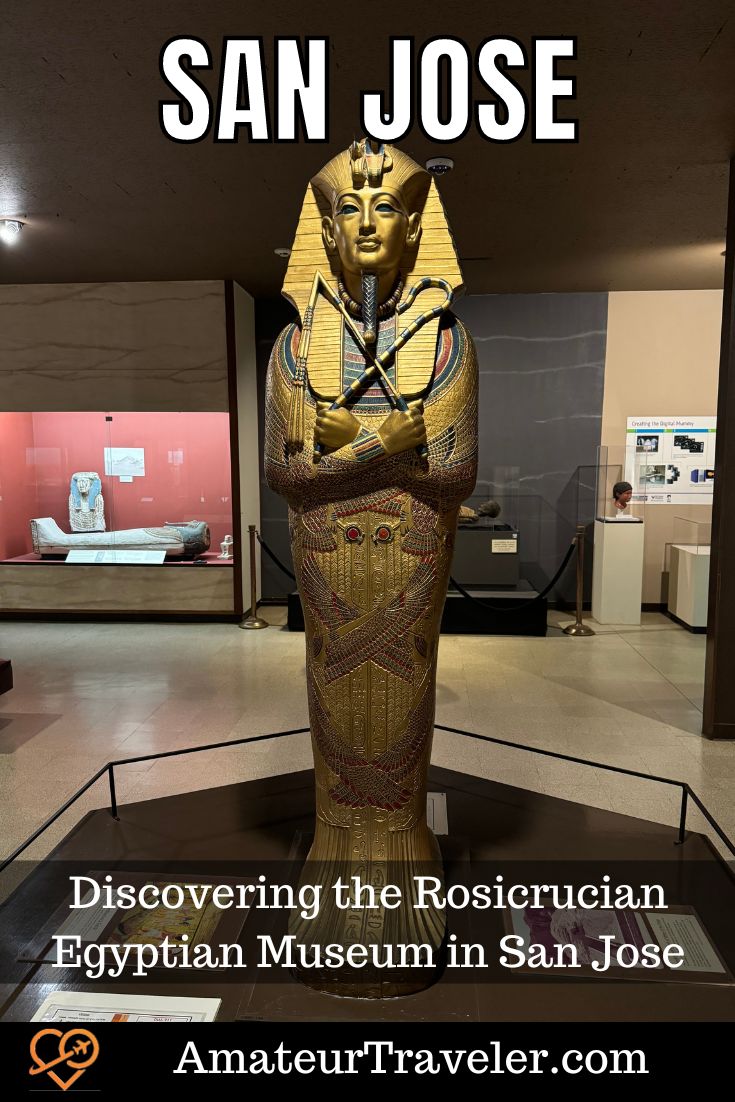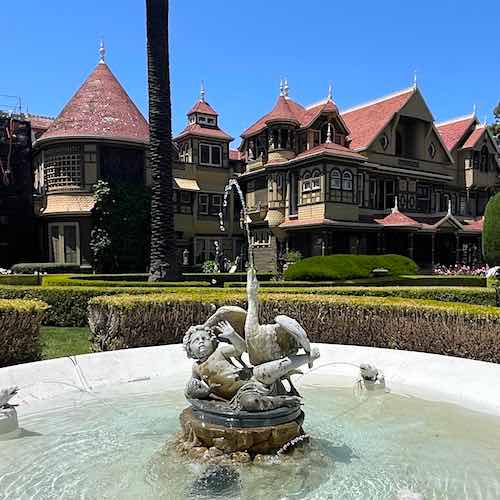
I have been to Egypt and the Museum of Egyptology in Cairo. Who would expect the second-best museum about ancient Egypt I have seen to be in San Jose?
The Rosicrucian Egyptian Museum, located in the Rose Garden neighborhood, offers a fascinating journey into ancient Egypt. Housing the largest collection of Egyptian artifacts on display in Western North America, the museum is a treasure trove of history and culture.
Table of contents: ()

Replica of the sarcophagus of Tutankhamun
What You’ll See at the Rosicrucian Egyptian Museum
The Rosicrucian Egyptian Museum in San Jose offers an impressive and immersive exploration of ancient Egypt through its extensive collection of artifacts and exhibits. Here’s a deeper look at what you can expect to see during your visit.

Mummies and Burial Practices
The museum houses several real mummies, including both human and animal examples, such as a mummified cat. The exhibits provide insight into the ancient Egyptian beliefs about the afterlife and the complex mummification process.

In ancient Egypt, mummification was designed to preserve the body after death, ensuring the deceased’s journey to the afterlife. The practice involved removing internal organs, drying the body using a substance called natron, and wrapping it in linen. Major organs were preserved separately in jars. The body was then placed in a sarcophagus. This ritual, lasting around 70 days, was rooted in religious beliefs about the afterlife, where preserving the body was essential for the soul’s survival.

The jars used in the mummification process to store the internal organs were called canopic jars. These jars typically had lids shaped like the heads of the four sons of Horus, each protecting a specific organ: the stomach, intestines, lungs, and liver. The heart, believed to be the seat of the soul, was usually left in the body, and the brain was often discarded. The canopic jars were an important part of the burial ritual, ensuring the organs were preserved for the afterlife.
- Book Your Accommodation HERE
- Get a Car Rental
- Buy Travel Insurance
- Search for Great Tours HERE

Tomb Replicas
The Rosicrucian Egyptian Museum houses an impressive replica of an ancient Egyptian tomb designed to give visitors an immersive experience of what burial chambers in Egypt would have been like. The replica is modeled after the tombs from the New Kingdom in the Valley of the Kings, where many Egyptian pharaohs were laid to rest. The design includes painted walls adorned with hieroglyphs and scenes depicting the journey of the deceased into the afterlife, a crucial aspect of Egyptian burial traditions.

The tomb’s layout mimics the structure of real Egyptian tombs, with multiple rooms and passageways leading to the burial chamber. Visitors can see replicas of sarcophagi and artifacts that would have accompanied the deceased in their journey. The artwork and inscriptions detail religious and cultural beliefs about the afterlife, providing insight into the funerary practices and the significance of preserving the body for the soul’s eternal life.

It did remind me of being in the Valley of the Kings, which I had a chance to do on the Amateur Traveler Egypt trip in 2010. The surprising thing about the Valley of the Kings is that the colors of the paintings on the walls are as vibrant as those depicted here, even though they date from the “New Kingsdom” 1539–1075 BC.
Egyptian History
When we talk about ancient Egypt, we are not talking about only one period. Before your visit, it might be useful to familiarize yourself with a basic timeline of the history of ancient Egypt. The timeline of ancient Egypt is traditionally divided into several major periods, spanning over 3,000 years of history, from around 3100 BCE to 30 BCE. Here’s a breakdown of the key periods:
1. Predynastic Period (c. 6000–3100 BCE)
This period predates Egypt’s unification. It saw the development of agriculture, small settlements along the Nile, and the rise of regional cultures such as Naqada and Badari. The foundations of Egyptian culture, religion, and art were laid during this time.
2. Early Dynastic Period (c. 3100–2686 BCE)
During this era, Egypt was unified under the first pharaoh, King Narmer (also known as Menes), marking the start of the 1st and 2nd dynasties. The pharaohs established centralized rule, and hieroglyphic writing began to develop. Major advancements in governance and religion also occurred.

Pyramid of Giza
3. Old Kingdom (c. 2686–2181 BCE)
Often referred to as the “Age of the Pyramids,” this period saw the construction of the great pyramids at Giza under pharaohs such as Khufu, Khafre, and Menkaure (4th Dynasty). The Old Kingdom marked a high point in centralized royal power, monumental architecture, and advancements in art and culture.
4. First Intermediate Period (c. 2181–2055 BCE)
After the decline of the Old Kingdom, Egypt experienced political fragmentation and instability. Local rulers, or nomarchs, gained power, and the pharaoh’s centralized authority weakened. Economic challenges and decentralization characterize this period.
5. Middle Kingdom (c. 2055–1650 BCE)
The Middle Kingdom began with Egypt’s reunification under Mentuhotep II of the 11th Dynasty. This period saw a resurgence in art, literature, and architecture and strengthened governance. Pharaohs like Amenemhat I and Senusret III expanded Egypt’s borders and consolidated their power.
6. Second Intermediate Period (c. 1650–1550 BCE)
During this period, Egypt was again divided and partially controlled by foreign rulers known as the Hyksos. The Hyksos ruled parts of northern Egypt, while native Egyptian dynasties held power in the south. This era was marked by internal strife and foreign influence.

Luxor
7. New Kingdom (c. 1550–1070 BCE)
The New Kingdom is often considered the height of ancient Egyptian power and wealth. Pharaohs such as Ahmose I, Hatshepsut, Thutmose III, Akhenaten, Tutankhamun (King Tut), and Ramses II ruled during this time. The period was marked by military expansion, impressive monuments (such as temples at Karnak and Luxor), and vibrant art. This era also saw religious reform under Akhenaten, who promoted the worship of the sun god Aten.
8. Third Intermediate Period (c. 1070–664 BCE)
Following the decline of the New Kingdom, Egypt once again fragmented into smaller, competing kingdoms. This period was characterized by political instability, foreign invasions (by the Nubians and Libyans), and weakened central authority.
9. Late Period (c. 664–332 BCE)
Egypt regained some stability under the 26th Dynasty (Saite Dynasty) but was increasingly influenced by foreign powers, including the Assyrians and Persians. This period ended with Alexander the Great’s conquest of Egypt in 332 BCE.

Cleopatra VII
10. Ptolemaic Period (332–30 BCE)
After Alexander’s death, Egypt was ruled by the Ptolemaic Dynasty, a Greek-Macedonian line of pharaohs. This period saw a fusion of Greek and Egyptian cultures, which eventually led to the decline of Egyptian power. Cleopatra VII, the last pharaoh, ruled during this time. Her death in 30 BCE, following the Roman conquest, marked the end of ancient Egypt as an independent civilization.
11. Roman Egypt (30 BCE–641 CE)
Egypt became a province of the Roman Empire after Cleopatra’s death. While Roman rule marked the end of ancient Egyptian sovereignty, the influence of Egyptian culture, religion, and art continued, particularly in the Roman adaptation of Egyptian deities and the continuation of Egyptian religious practices.

Artifacts from Daily Life
Religious Artifacts and Deities
A variety of statues, amulets, and carvings depict the pantheon of Egyptian gods and goddesses. These artifacts provide insight into the religious practices and the symbolic meanings behind the deities.
Papyrus Collection
The museum features a collection of papyrus documents displaying ancient writing techniques, including administrative records, religious texts, and literature.

Special Exhibits
- Alchemy Exhibit:
- This unique exhibit explores the connection between ancient Egyptian practices and later alchemical traditions. It includes artifacts and information on the mystical and scientific aspects of alchemy.
- Interactive and Educational Displays:
- The museum offers interactive displays and educational programs, including an AI robot named Thoth that engages visitors with facts and stories about ancient Egypt.
- 3D Artifact Models:
- Visitors can explore 3D models of select artifacts, which offer a detailed view of the pieces’ craftsmanship and artistry.
Additional Features
- Rosicrucian Park: In addition to the museum, Rosicrucian Park includes beautiful gardens, a planetarium, and a research library, offering a peaceful setting for further exploration.
- Educational Programs: The museum provides a range of educational programs and workshops for all ages, making it a great destination for families and students.
The Rosicrucian Egyptian Museum offers a rich and engaging experience for anyone interested in the history and culture of ancient Egypt, providing a comprehensive look at the daily life, religious beliefs, and technological advancements of this fascinating civilization.

Who Are the Rosicrucians?
While I am a big fan of the museum, I can’t say I plan to become a Rosicrucian anytime soon.
Rosicrucians are members of a worldwide brotherhood that claims to have esoteric wisdom passed down from ancient times. The Rosicrucian movement originated in early modern Europe in the 17th century. The name comes from the order’s symbol, a rose on a cross, similar to Martin Luther’s family coat of arms. Rosicrucian teachings combine occultism with other religious practices and beliefs, including Christian Gnosticism, Hermeticism, and Jewish mysticism. The central belief of Rosicrucianism is that its members have secret wisdom passed down to them from ancient times.
How Long to Visit
A typical visit lasts 1 to 2 hours, allowing you to explore the museum’s extensive collection and exhibits fully. The self-guided tour is enhanced by an app that you can download to enrich your experience.
The museum has a smartphone app that will help you plan your visit.
Location and Accessibility
The museum is situated in the Rose Garden neighborhood at 1660 Park Avenue, San Jose, CA 95126. Free and metered street parking is available nearby.
Hours and Admission
The museum is open Friday from 10 am to 5 pm and on Saturday and Sunday from 11 am to 6 pm.
Admission prices are as follows:
- Adults (18-64): $10.00
- Seniors (65+), Students with ID, and Children (7-17): $8.00
- Children 6 and under: Free
Discounts are available for KQED members and military personnel.

Additional Attractions
In addition to the Egyptian Museum, Rosicrucian Park is home to a planetarium, a peaceful garden, and other attractions related to Rosicrucian history and philosophy.
Visiting the Rosicrucian Egyptian Museum offers a unique opportunity to delve into the mysteries of ancient Egypt while enjoying the serene surroundings of Rosicrucian Park. Whether you’re a history buff, a student, or just curious, the museum promises an enriching experience.





 The Winchester Mystery House: California’s Original Haunted Mansion?
The Winchester Mystery House: California’s Original Haunted Mansion?
